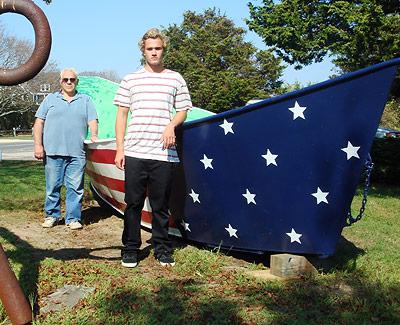Stars and Stripes Flag Dory Is Restored

As Bonac-American as bluefish and pancakes, striped bass and civil disobedience, Budweiser and black Labs, the red, white, and blue dory that sits on the front lawn of the East Hampton Historical Society’s Marine Museum in Amagansett — angled slightly as though lifted by a wave — has been restored, thanks to an Eagle Scout and his grandfather.
Chris Westergard, 17, a senior at East Hampton High School, chose to refurbish the dory from a list of Lions Club projects deemed Eagle Scout badge-worthy.
His grandfather John DiSunno of Amagansett agreed to lend a hand, as did a number of local stores that enthusiastically donated materials for the project. Donors included Aboff’s Paint and Wallcovering of East Hampton, which came up with red, white, and blue paint plus the lime-green (bordering on chartreuse) color of the boat’s interior. The shade would seem incongruous without knowing the boat’s history.
The dory was built for haulseining at the back of Stuart’s Fish Market in Amagansett by Stuart Vorpahl and Tom Field, in 1976. That was 15 years before the traditional method of fishing was outlawed by the state. It was the center of a partnership formed by Mr. Field, Billy Vorpahl Sr., and Dan King.
The bright lizard green was the original color of the entire dory, Mr. DiSunno said, quite a sight when it was launched from the partners’ trailer and pickup, and as it paid out the semi-circle of net to encircle shore-grazing bass.
’Seventy-six was the nation’s bicentennial year, so Jimmy Lester painted three-quarters of the dory’s hull with red and white stripes, with white stars against a field of blue on the bow.
After Billy Vorpahl Sr. began working at Stuart’s on a more regular basis, and Mr. Field got busy excavating, Mr. King became the dory’s fishing captain, heading up one of several haulseine crews working in East Hampton at the time.
In 1990, the ocean seine was outlawed as a method of catching striped bass. The Flag Dory, as it became known, became the indelible image here of a civil-disobedience protest against the state ban. The protest was held at Indian Wells Beach in Amagansett with the support of town officials and a celebrity boost from Billy Joel.
Chris Westergard said the dory’s original flooring had rusted. Using steel plate donated by Bridgehampton Steel and Ron Sullivan of Montauk, his grandfather welded a new bottom. Weep holes and a drain were added to fight corrosion in the future.
Riverhead Lumber supplied wood for a seat. East Hampton Plumbing supplied piping to rebuild the dory’s gunwales where they had been worn by nets and weather. Rust-busting wire brushes were donated by East Hampton Hardware.
The resurrection was begun during the second week of August and completed in three weeks, working two days each week, 9 to 10 hours a day, with the help of Chris’s fellow scouts Rick Nardo, Nick Pucci, Brendon DiSunno, and Mike Gherardi.
Oh, and the new white stars that now grace the dory’s bow shine compliments of the Sign Language store on Gingerbread Lane.
